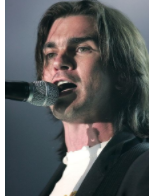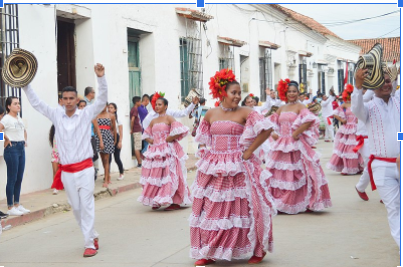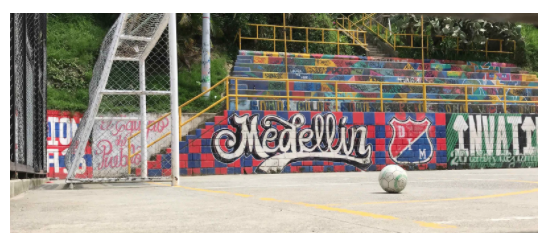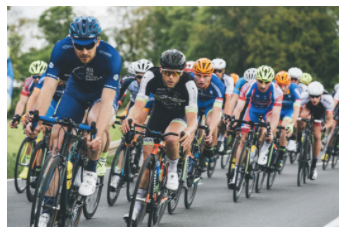B
Brittany Schwikert
AP Spanish Language 🇪🇸
54 resourcesSee Units
5.4: Entertainment and Sports 🏟️
When it comes to entertainment in Spanish speaking countries, the first word that comes to mind is ¡⚽FUTBOL⚽! But let’s take a look at Colombia where there’s more ways to have fun than just soccer.
Música 🎵
Tons of famous artists call Colombia home. Shakira, Carlos Vives, Juanes, J Balvin, Maluma, and Karol G all trace their roots to Colombia.
Shakira
Shakira is originally from the northern coastal town of Barranquilla and is considered una diosa to Colombia, widely hailed as the Queen of Latin Music. She’s been topping charts since 2001 with her debut of “Whenever, Wherever.” She performed at the 2008 Inauguration for President Barack Obama and with Jennifer Lopez in the 2019 Super Bowl Halftime Show. Not to mention she’s also won 3 Grammy Awards, 12 Latin Grammy Awards, 4 MTV Video Music Awards, and 7 Billboard Music Awards. ¡Andále, Shakira!

Juanes
Juanes is a Colombian guitarist, singer, songwriter and activist widely known throughout the world. Juanes has used his platform to raise awareness of issues plaguing Colombia through condemning the violence and corruption in his home country. In 2006 Juanes began his own philanthropic foundation dedicated to eradicating Colombia’s land mines and supporting victims of land mine accidents. He continues to be an artist beloved to his fans and to those whose lives he’s been able to positively impact through his foundation, Mi Sangre Foundation.

Karol G
Carolina Girlado Navarro is a Colombian singer and songwriter. Her music blends both reggaeton and Latin trap, but can also be known to include reggae and sertaneja. In 2018, she won the Latin Grammy Award for Best New Artist and has collaborated with some of Latin America’s biggest stars, such as J Balvin, Daddy Yankee, and Ozuna.

Baile 💃
The most well known and popular style of dance in Colombia is la cumbia. The dance is said to have originated during Colombia’s struggle for independence in the 1820’s. Given Colombia’s diverse population Cumbia infuses rhythms and cultural components from American Indians, Europeans, and Africans enslaved during colonial times.
Cumbia
Colombian’s diversity can be seen through this specific type of dance. Many musicians, dancers, and historians believe cumbia’s percussion came from African influence, and the use of the cane flute came from the Native Colombian indigenous population, while the traditional dress was brought over by the Spaniards.

Deportes ⚽
In nearly all Spanish-speaking countries, soccer (or fútbol) is considered the national sport. However there are still other non traditional sports that many Colombians enjoy both as spectators and as participants.
Fútbol
Like many other countries, soccer reigns supreme in Colombia. The glory years for Colombia’s national team were during the 1990’s when they qualified for 3 world cups and again in 2001 after they won the Copa America. Yet for many Colombians, club football is more important than the national team. Although the national team is composed of Colombians, the majority of the players play their soccer in foreign nations and have largely tangential ties to Colombia.
By contrast, the club teams have strong ties to the local area in which they play. The majority of the players on the club teams are from that area of the country and also live there, therefore meaning the fans of the team feel a stronger tie to the local teams as they consider it an extension of themselves.

Ciclismo
Cycling quickly gained popularity in the 1970s in Colombia when the municipal government chose to close down 120km of the city’s streets to cars for cyclists, skaters, and pedestrians. These pathways are known as ciclovias and are popular in all major Colombia cities.
On Sunday mornings and national holidays, the ciclovias are reserved for competitive sport and races. Yet throughout the rest of the week, the bikeways are open to encourage locals to commute across the city without causing additional pollution through cars.

Tejo
In 2000, Congress declared Tejo the national sport of Colombia. The name of the game originates from its puck, or “tejo” that’s a metal object that’s thrown from about 20 meters to a target. The target consists of mechas or folded triangles containing gunpowder, that explode upon impact. Participants greet each bang and mini explosion with a loud cheer.

Strive for Five Vocab 🔑
- Reggaeton - music style that originated in the Caribbean and has been influenced by hip hop, Latin American, and Caribbean music. Vocals can be sung either rapping or singing and are usually sung in Spanish
- Sertaneja - music style popular throughout Brazil and Colombia that frequently uses duos for vocals and has a pop feel
- Cumbia - a style of dance that originated in Latin America and involves cultural elements from American Indians, Africans enslaved during colonial times, and Europeans
- Fútbol - soccer
- Futbol americano - American style football
- Ciclovia - bike pathways created in major cities
- Tejo - traditional throwing sport in Colombia
Browse Study Guides By Unit
👨👩👧Unit 1 – Families in Spanish-Speaking Countries
🗣Unit 2 – Language & Culture in Spanish-Speaking Countries
🎨Unit 3 – Beauty & Art in Spanish-Speaking Countries
🔬Unit 4 – Science & Technology in Spanish-Speaking Countries
🏠Unit 5 – Quality of Life in Spanish-Speaking Countries
💸Unit 6 – Challenges in Spanish-Speaking Countries
🙏Exam Reviews

Fiveable
Resources
© 2023 Fiveable Inc. All rights reserved.